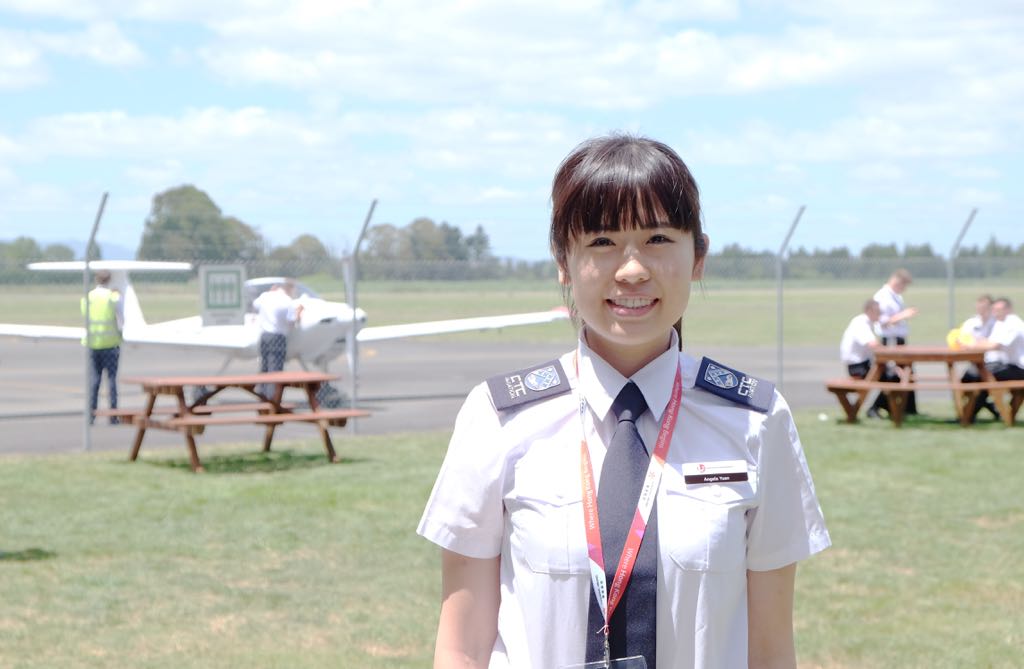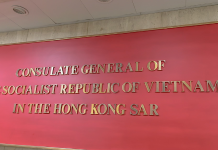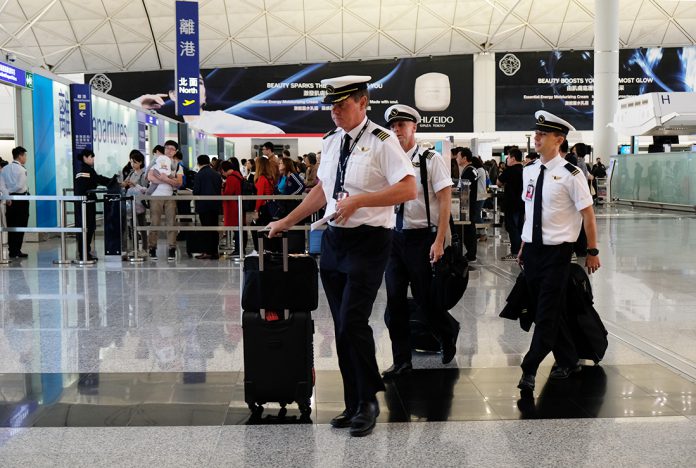Hong Kong plays catch-up as lagging aviation education contributes to labour shortage
By Iris Yeung & Tommy Yuen
O
n the July 31 2016, dozens of activists marched through the terminal building in Hong Kong’s International Airport (HKIA) to oppose a HK$141.5 billion project to build a third runway and associated facilities. They said the project would be a white elephant and cause untold environmental damage, including threatening the survival of the Chinese white dolphin. But dissenting voices in the community failed to stop the project.
The three-runway system (3RS) is scheduled for completion in 2024 and aircraft movements are set to increase from the 68 flights per hour on the current two-runway system to 102 flights per hour. Together with the expansion of Terminal 2 and other facilities, authorities predict an extra 50,000 extra staff will be required to perform various jobs in the expanded airport. However, even at its current scale, industry insiders say the airport is short-staffed and the cultivation of aviation talent has been under-developed for years.
Law Cheung-kwok, the director of policy at the Aviation Policy and Research Centre at the Chinese University of Hong Kong, says that aviation education in Hong Kong lags behind the rapid development of the sector, and it is too late to start filling the void. This despite the fact that the Basic Law highlights the status of aviation in Hong Kong.
“There are only two ‘centres’ in the Basic Law that Hong Kong is positioned as, one is as a financial centre, the other is aviation. They are important industries for Hong Kong’s economic production,” says Law. “Indeed, the financial industry is highly valued, but the attention paid to [Hong Kong’s role as an] aviation hub is relatively low.”
According to Article 128 of the Basic Law, the Hong Kong government should maintain “the status of Hong Kong as a centre of international and regional aviation” but Law points out the absence of an aviation school in any of the University Grants Committee-funded universities in Hong Kong.
“If this field is that important, we should have had it [general aviation education] long ago,” he says.
Some tertiary institutes have launched aviation courses in recent years. The Hong Kong Polytechnic University established the Interdisciplinary Division of Aeronautical and Aviation Engineering in 2016. It also offers degree programmes in aviation management. The Hong Kong University of Science and Technology started offering a Bachelor’s degree in Aerospace Engineering in 2015 and Master’s degrees in Aeronautical Engineering and International Air Transport Operations Management respectively in 2016.
Other education institutes offer self-financed higher diplomas or certificates courses. One example is the HKU School of Professional and Continuing Education (HKUSPACE)which has offered a range of aviation programmes since 2006. These include diploma courses in aviation management, ground services, airport operation and a certificate for the Australian Private Pilot License (PPL). There are over 1,000 total annual enrolments.

Last year, the Airport Authority Hong Kong (AAHK) established the Hong Kong International Aviation Academy (HKIAA) which offers a range of day camps, beginners courses, certificate programmes with 12-month paid internships, professional short courses for existing industry personnel and academic courses such as a Master’s degree and diploma and top-up degree courses. In all, the academy offered more than 177 courses in 2017 covering airport operations and management, air traffic control, aviation security and aviations services. The HKIAA says the offerings reached more than 5,500 participants last year.
Lam Siu-ming, the senior programme director of the College of Life Sciences and Technology at HKUSPACE sees the establishment of the HKIAA as a positive development.
“We are comparatively slow [in aviation education], but at least we have started, I hope we can catch up,” he says.
Lam thinks aviation education was slow to get off the ground in Hong Kong in part because of its geographical location. The available air space limits the flying experience young people can have, and this is an intractable problem, particularly when it comes to the training of local pilots.

Lam says he has met many young people who dream of becoming pilots. Over the past decade, 98 graduates from HKUSPACE aviation programmes have become airline pilots. But the college can only guide students through the syllabus of the private pilot’s licence programme. In order to obtain a PPL, which is compulsory for a qualified pilot, students must undergo further training overseas at their own expense. With two more advanced qualifications required before one can become a commercial pilot, it costs a total of around HK$1 million to train to be a pilot.
While few can afford the training, Cadet Pilot Programmes (CPP) launched by local airlines do subsidise those with talent to realise their aviation dreams. Currently, Cathay Pacific, Cathay Dragon and Hong Kong Airlines organise such programmes. Those who make it through the tough rounds of theory and practical tests, are sponsored to undergo pilot training in Australia and New Zealand.
Hong Kong Airlines launched their first CPP in 2017. Of the more than 4,000 applicants, only 10 were selected. Lam thinks the stringent selection methods and requirements are necessary.
“As a passenger, you’ll be frightened if the pilot is not up to standard. The industry would not ease the requirements.”

Photo Courtesy of Angela Yuen Yan-chi
Angela Yuen Yan-chi, 29, was one of the lucky few to join the first-batch of Hong Kong Airlines cadet pilots. She says only 7.5 per cent of the airline’s 560 pilots are local. The percentage will increase when the cadets complete their flight training but it will take years before the percentage rises significantly.
There is a global shortage of experienced pilots but Yuen says the problem is particularly acute in Hong Kong because the territory is simply too small. “The airspace is not enough to share with neighbouring cities like Macau and Shenzhen,” she says, adding that Shek Kong Airfield is the only place to carry out flight practice.
“The only runway available in Shek Kong Airfield makes the cost of flying expensive.”
Krizto Chan Ho-ying, a 27-year-old aviation enthusiast agrees that aviation education in Hong Kong is not widely affordable. Chan has applied for the cadet pilot programmes for Cathay Pacific, Cathay Dragon and Hong Kong Airlines but so far without success.
“It’s a bit of a luxury here, even for those of us who are so into it, we have to save money for years before we can have our first flight,” she says.
Over the years, Chan has invested a lot to prepare herself for the CPP assessments. During her university years, she attended courses at the Hong Kong Youth Aviation Academy, a non-profit organisation run by practising professionals in the aviation industry, which aims to help aspiring pilots fulfill their goals. She underwent flight training in New Zealand too and holds a private pilot licence. None of this guarantees a place in the local cadet pilot programmes.
“You have to be the top, you have to be very sharp, and you have to be lucky,” says Chan.
The shortage of aviation personnel is not limited to pilots. More aviation courses have become available recently but the historical inadequacy of aviation education provision has exacerbated the manpower shortage problem in the industry as a whole.
Cheung Shu-wang, chairman of the Staffs and Workers Union of Hong Kong Civil Airlines, estimates there is currently a labour shortfall of 5,000 airport workers. While safety is not affected yet, services are.
The most noticeable and immediate impact is longer waiting times for luggage but Cheung says there is insufficient staff in many areas, including parking aprons, check-in counters, baggage reclaim, technicians, pilots and managers. Cheung says these shortages will affect airport operations and service quality. For its part, the AAHK does not respond to the criticism directly. But they say the use of technologies, such as the “baggage tagging robot” and “trolley counting system” can help improve operational efficiency.
As to whether Cheung thinks the setting up of the HKIAA can help ease the problem, he is not so sure.
“I think its efficiency and planning [in cultivating personnel] cannot really catch up with the growing demand for airport ground staff,” he says.
While the new institute offers courses on a range of high-end skills, Cheung thinks the airport is in urgent need of semi-skilled workers at the parking apron. He says the union will propose feasible policies to the AAHK.
Jeremy Tam Man-ho, who served as a commercial pilot before becoming a Civic Party lawmaker, says the government has been, characteristically, slow to act.
“Every time, it’s not until there really aren’t enough people that the government thinks of methods to magic up some people. So that’s why you’ll see the establishment of HKIAA, it’s really to complement the third runway.”
Tam thinks the government is on the right track to develop aviation. It now has policies in place and is following them, but he still thinks they have not done enough.
He adds: “I think the launch of HKIAA is appropriate, but there is not enough promotion, also the courses are not broad enough and some of them are very expensive.”
For those already employed at the airport, some financial support maybe available. The HKIAA says applicants for 20 of the professional courses can apply for a refund of 80 per cent of the fees, up to a maximum of HK$18,000 on completing the courses under the government’s Professional Training and Examination Refund Scheme. And the fees if some courses are waived for airport staff “if they enroll through their respective organisations”, says the HKIAA.
But in order to attract new recruits, Tam suggests airlines, the HKIAA and aircraft engineering companies should offer more internships to encourage students to assess their aspirations and suitability for various posts in the sector. While companies may see offering internships as a kind of social responsibility on their part, Tam points out they also benefit from nurturing new blood. Therefore, he wants to see more cooperation between the industry and education institutes, so that companies can observe and hire suitable candidates upon their graduation.
Former labour sector lawmaker Ip Wai-ming, who is now the deputy secretary of the Staffs and Workers Union of Hong Kong Civil Airlines, says the high turnover rate is another factor of the manpower shortage in the industry. He thinks the staff shortage problem should be solved through the unions, government and related corporations working together.
Ip believes the government should invest in order to get rewards, especially if it regards aviation as an important economic pillar of Hong Kong.
“They have to make people be willing to enter the industry, giving them the feeling that this is an industry with prospects and development, which can lead them to make a living.”
Edited by Jade Li







































